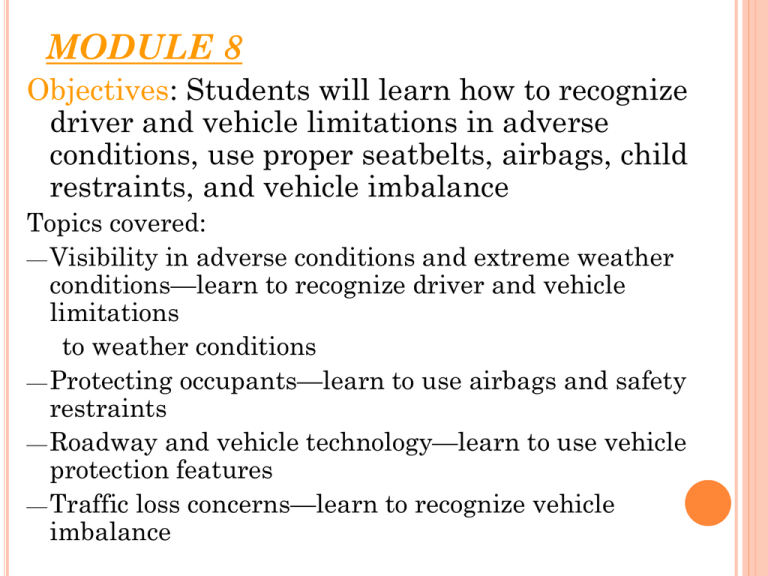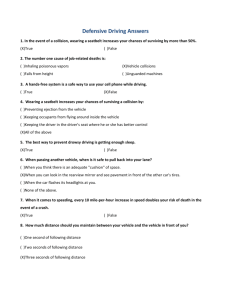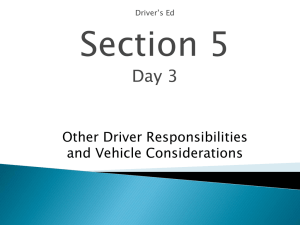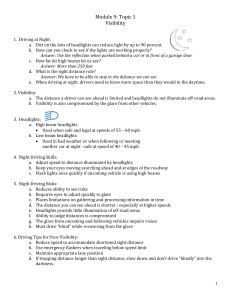Driver & Vehicle Safety: Adverse Conditions & Technology
advertisement

MODULE 8 Objectives: Students will learn how to recognize driver and vehicle limitations in adverse conditions, use proper seatbelts, airbags, child restraints, and vehicle imbalance Topics covered: — Visibility in adverse conditions and extreme weather conditions—learn to recognize driver and vehicle limitations to weather conditions — Protecting occupants—learn to use airbags and safety restraints — Roadway and vehicle technology—learn to use vehicle protection features — Traffic loss concerns—learn to recognize vehicle imbalance VISIBILITY CONDITIONS At night, visual acuity is severely limited—our eyes adjust very quickly to light but very slowly to darkness If a driver is blinded by the lights of an oncoming vehicle, he/she should reduce speed, look to the right, and glance briefly ahead —Approximately 90% of our driving clues depend on vision —One method for reducing glare at night is to clean your windshield—dirty headlights can reduce visibility up to 90% North Carolina law requires the use of headlights whenever the windshield wipers are in use * the air conditioner will help to defog interior windows —Overdriving your headlights means that you cannot stop in the distance illuminated by your headlights Visibility Conditions When driving at night with low beam headlights, the maximum safe speed is 45 mph When driving in fog, you should use low beam lights and the maximum safe speed is 45 mph A wet roadway is most slippery when the rain first begins- as more streets and parking lots are built, flooding problems will increase Bridges and overpasses can be more hazardous than other roads during cold weather, because those surfaces freeze before other road surfaces — Hydroplaning is caused by the buildup of water between the vehicles tires, road surface, loss of steering, and loss of braking — Two dangers of driving through deep water are that (a) the roadbed may be washed away and (b) water might cause your engine to stall out Visibility Conditions Nearly 1/2 of all flash flood fatalities are vehicle related To dry wet brakes, you should brake gently using your left foot while accelerating with your right foot If you begin to slide on a slick surface, look and steer in the direction you want to go — It is not safe to stay close to the shoulder when driving through water Sand, gravel, or even cat litter can help tires gain traction on slick surfaces Dust or sand storms can reduce visibility to ½ mile or less, strike with little warning, and often damage oil and air filters Buffeting results from high winds—when driving into a headwind, you may need to accelerate more Before starting a vehicle in snow, check to be sure that the exhaust system is clear—the use of cruised control does not help control a vehicle in snow Protecting Occupants North Carolina law requires all front seat passengers and any person less than 16 to wear a seat belts When driving an airbag equipped vehicle Sit at least 10 inches from the steering wheel—tilt the steering wheel should be tilted toward the chest Your hands should be on the lower half of the steering wheel: 9:00/3:00 or 8:00/4:00. The lap belt should be worn across the hips In 2000, 60% of the teens killed in motor vehicle related crashes were not wearing a safety belt An airbag….. Automatically inflates in frontal crashes at speeds up to 200 mph Distributes the force more evenly across the body Protecting Occupants and Roadway Features Sixty percent of teens killed in the year 2000 motor vehicles related crashes were not wearing a seat belt Even if your vehicle has air bags, you need to use safety belts—new vehicles now may be equipped with side air bags Pregnant women should always wear seat belts If an infant must ride in the front seat, the air bag should be turned off: the safest place for children is in the back seat Adjust the position of the head restraint to be just above the ears When you ride in a moving object, your speed is equal to the speed of the moving object It is not advisable to remove the radiator cap to release steam and cool an overheated engine Rumble strips are grooves or rows of raised pavement markers placed on the shoulder to alert inattentive drivers Roadway Features Message signs are used to warn drivers of dangers ahead Breakaway sign support posts are break-away systems designed to cause less damage and impact to vehicles and make it safer for drivers upon impact Crash attenuators are vinyl liquid or sand filled drums that have been installed in a specific geometric array in front of the hazards Median barriers are prefabricated islands that are placed in the center of the roadway leading up to a highway-rail grade crossing Extruder terminals reduce hazards of guardrails—the kinetic energy of the impacting vehicle is absorbed by the force required to reduce the W-Beam shape of the guardrail to a flatter section Tire pressure increases as the tires get hot—the recommended antifreeze/water mixture is 50/50 Automotive Technology ABS—(Anti-Lock Braking System) allows the driver to steer while braking—prevents tires from sliding and generally shortens stopping distances on wet surfaces In vehicles without ABS, a quick jab of the brakes may help control front wheel traction loss Traction Control sends power to wheels with most traction—designed to activate brake sensors, which do not allow the wheels to spin Suspension Control adjusts vehicle balance through adjustment of fluid or air pressure when too much weight is suddenly transferred to a given shock absorber or strut ESP—(Electronic Stability Program) activates when vehicle is not going in the direction it is being steered Traction Loss Concerns Good traction starts with your vehicle’s tires—a drivers first indication of traction loss comes from motion based sensory input In skid control, it is critical that the driver look where he/she wants the car to go and steer in the intended direction Traction control sends power to wheels with most traction and allows a vehicle to start, stop, and/or change direction Under-steering results from loss of front traction—a good technique to minimize under-steering is to slow down before entering a curve or turn In rear wheel loss of traction, the rear wheels are trying to lead The following conditions may affect traction: Surface Materials Surface Conditions Weather Conditions










